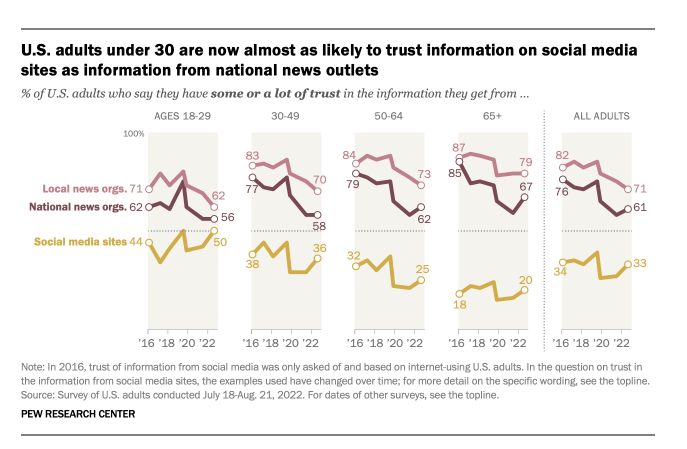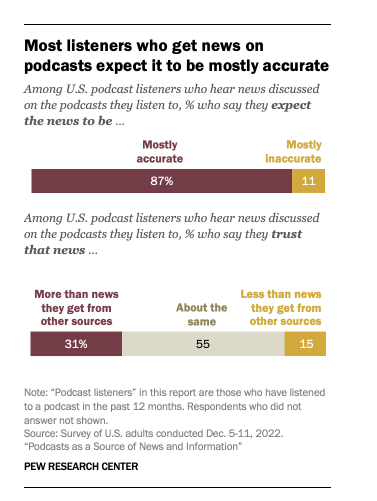Summary
- The media landscape has shifted, with traditional news outlets losing influence and alternative platforms like podcasts and social media gaining prominence.
- Both Kamala Harris and Donald Trump are adopting multi-platform strategies to target specific voter demographics, particularly those disengaged from traditional media.
- Harris’s media appearances on podcasts like Call Her Daddy and talk shows aim to reach young, female, and minority voters with tailored messaging.
- Trump is focusing on podcasts hosted by influencers to connect with younger, male audiences, using their platforms to bypass traditional political news channels.
- The shift in campaign strategies reflects the declining trust in traditional media, signalling the growing importance of personalised, direct engagement through alternative media.
Details
The media landscape has undergone a seismic shift recently, characterised by declining trust in traditional news outlets and the rise of alternative media channels. As campaigns adapt to this fragmented media environment, the strategies employed by candidates like Kamala Harris and Donald Trump offer key insights into how media consumption patterns have transformed.

Fragmentation of Media Consumption
The decline of traditional media’s dominance is driven by an increasing demand for personalised and ideologically aligned content. Audiences are turning towards podcasts, social media platforms, and independent news sources that align more closely with their values and preferences. This shift is leading political campaigns to engage voters across a broader range of media channels. While traditional outlets like television programmes and print media still hold value, they are no longer sufficient on their own to reach all voter demographics.
Kamala Harris, for instance, has embraced a diverse media strategy that includes traditional outlets alongside newer, non-traditional platforms. Her appearances range from shows like The View to the Call Her Daddy podcast, a move aimed at targeting specific voter groups, particularly women and younger voters. These platforms allow Harris to speak directly to audiences that traditional news programmes may not effectively reach, demonstrating a key adaptation to the fractured media landscape.
Targeting Demographics through Non-Traditional Platforms
The targeted use of non-traditional platforms reveals how campaigns are increasingly moving beyond the limits of traditional media to capture the attention of niche and often disengaged audiences. For example, Harris’s participation in the Call Her Daddy podcast highlights her intention to connect with younger female voters, many of whom are politically undecided. The themes discussed during this appearance—such as abortion access and challenges women face—are specifically chosen to resonate with this demographic.
Donald Trump has similarly adapted his campaign strategy by tapping into alternative media spaces. By appearing on podcasts hosted by influencers like Logan Paul and Theo Von, Trump is connecting with younger, predominantly male audiences. These podcast appearances provide a way to engage voters who may not follow political news through mainstream media channels. In doing so, Trump’s campaign is leveraging the trust these influencers have built with their audiences, further extending the reach of his message.
The Decline of Trust in Traditional Media
As campaigns increasingly utilise alternative media, they implicitly acknowledge a growing trend: declining trust in traditional media. Polls and studies repeatedly show a decrease in the public’s confidence in mainstream outlets. The proliferation of information sources has led to a splintering of news consumption, with voters seeking media that mirrors their own political and ideological views. Campaigns are now compelled to cater to these fragmented audiences, adopting a more tailored approach to media engagement.
Both Harris and Trump exemplify this approach. Their strategies suggest that connecting with today’s voters requires not just broader media engagement, but a sophisticated understanding of how audiences consume and process information. Engaging voters through influencers, podcasters, and talk show hosts who have already established credibility with particular groups is key to maintaining relevance in this media environment.
The New Rules of Political Media Engagement
The changing media landscape requires campaigns to be more versatile, employing strategies that go beyond traditional outlets and target niche audiences on a more personal level. Both Kamala Harris and Donald Trump’s media strategies reflect this shift, as they prioritise reaching voters through alternative platforms while still maintaining a presence in traditional media.
This evolution signals the increasing significance of personalised, direct communication in political campaigns. Candidates must now meet voters where they are—whether on podcasts, YouTube channels, or social media—to effectively deliver their messages. The use of non-traditional media is no longer a secondary strategy, but a primary means of engaging with an electorate that is more fragmented and ideologically diverse than ever before.
The success of these new approaches will likely define future campaigns, as the media landscape continues to evolve alongside voter expectations.

